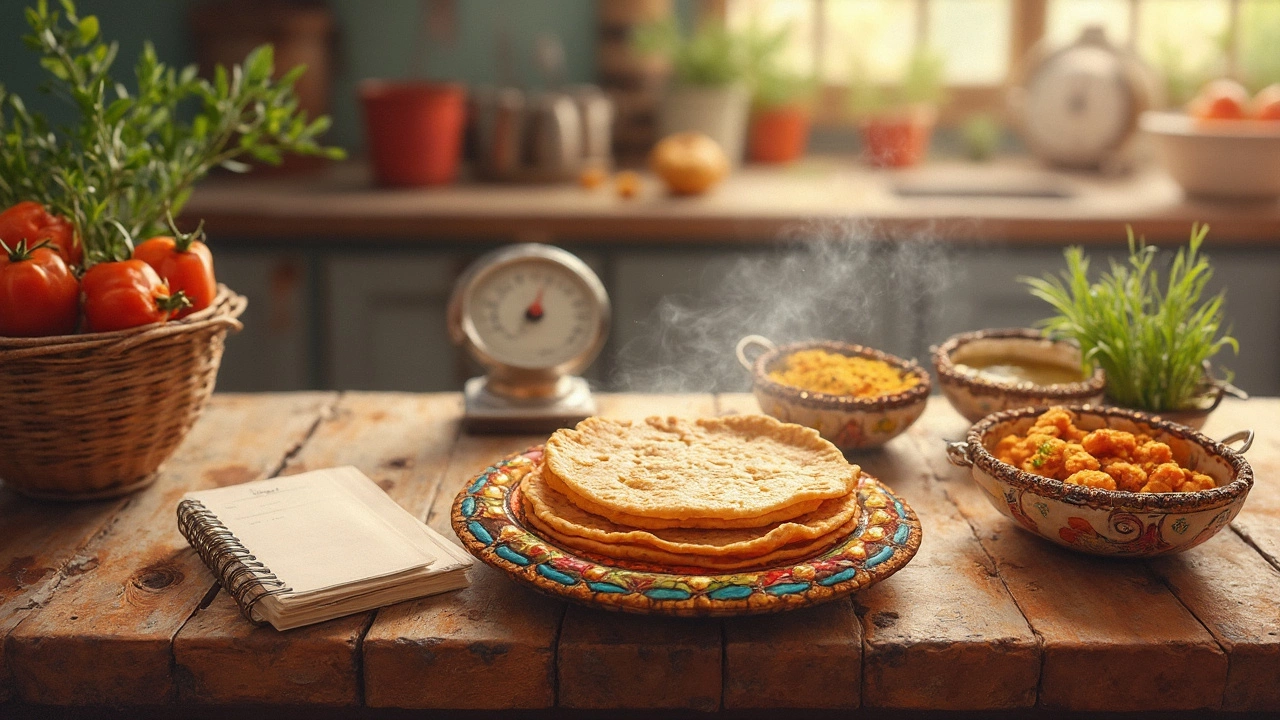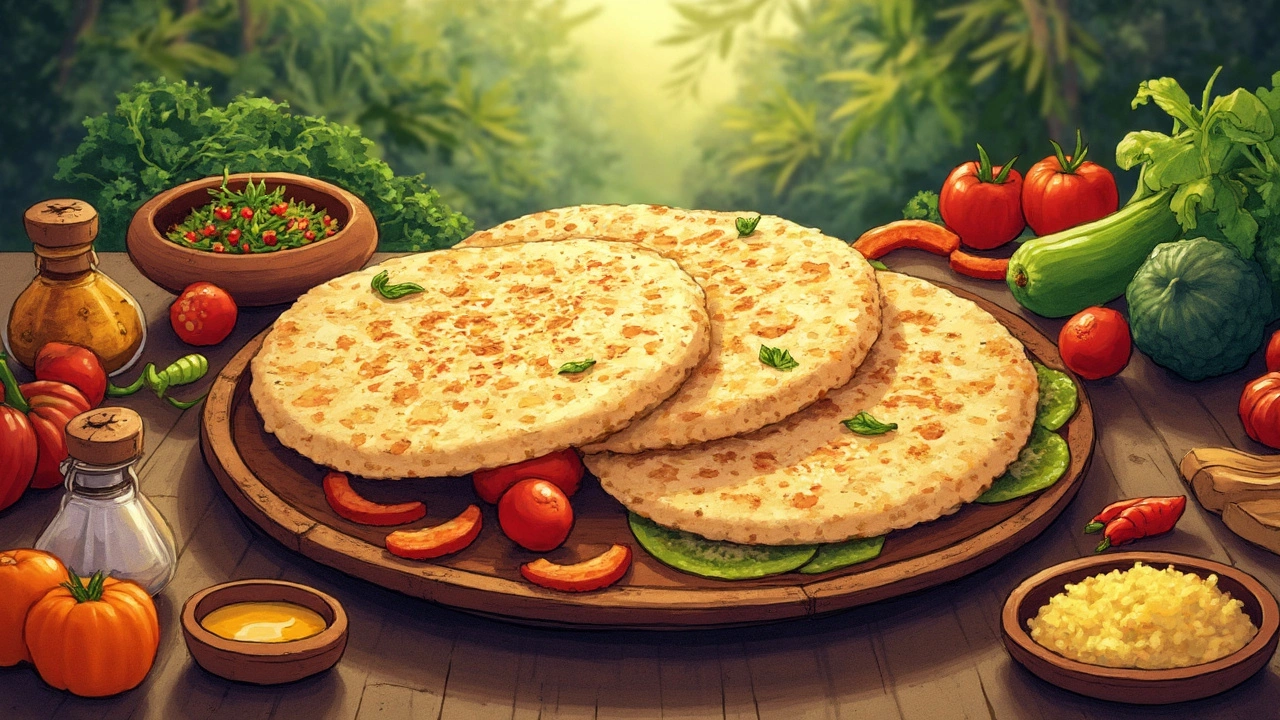How Much Calories in 1 Roti? Fit It Into Your Diet Smartly
 Feb, 23 2025
Feb, 23 2025
If you're counting calories but still crave your rotis, you're in good company. Knowing how much calories in 1 roti can be a game-changer for managing your diet without giving up this staple. On average, a plain roti contains around 70-80 calories. Not too bad, right? It's the perfect vehicle for your favorite dishes, but there's more to it than just numbers.
Including rotis in your diet the right way can keep your meals enjoyable and fulfilling. Tonight's roti paired with sabzi? Expect to add a few more calories. On average, an entire roti and sabzi meal can rack up anywhere from 250 to 400 calories, but here's the thing: it's all about how you prepare it.
Thinking of slathering some ghee on top? That adds flavor and about another 40-50 calories per roti, bringing a bit more complexity into your diet equation. It's all about balance and choosing what works for you. Calories in 1 roti with ghee can still fit into a health-conscious meal plan with a little planning and tweaking.
- Understanding Calories in Roti
- The Role of Rotis in a Balanced Diet
- Roti and Sabzi Combo: What to Expect
- Adding Ghee to Roti: How It Affects Calories
- Smart Tips for Including Rotis in Your Diet
Understanding Calories in Roti
Ever wondered how many calories in 1 roti? You might be surprised at how nutrient-dense this simple bread can be. A typical whole wheat roti has about 70-80 calories, most of which come from carbohydrates, with a little protein and almost no fat. It’s a staple for a reason—it's nutritious and filling.
Calorie Breakdown
The main ingredient in roti is whole wheat flour. This flour is packed with complex carbohydrates, providing energy for your day-to-day activities. That’s why rotis are a key component of meals in many parts of the world, especially in South Asia.
Here's a quick look at the typical nutritional content:
| Component | Per Roti (6-inch diameter) |
|---|---|
| Calories | 70-80 |
| Carbohydrates | 15g |
| Protein | 3g |
| Fat | 0.4g |
Why the Calories Might Vary
Wondering why some rotis might have more calories? A few things can influence this. The thickness of the roti and the amount of flour used can change the calorie count. Also, the cooking oil or grease you use to prepare them can add extra calories. So, if you’re keeping an eye on how much calories in 1 roti, consider these factors.
Keeping It Healthy
Here's a simple way to manage calories: opt for minimal oil and thinner rotis. When you’re trying out different recipes, don't forget to account for these changes because they can make a big difference in your diet. If you're baking them at home, measure your ingredients to stay on track.
So, next time you’re enjoying a meal, remember that this humble bread can fit well into your health goals. It’s all about making informed choices and tweaks where you can!
The Role of Rotis in a Balanced Diet
Rotis, with their humble origins, are actually power-packed players in our dietary line-up. They offer more than just a comforting bite of home; they bring nutritional benefits that are essential for a balanced diet. Let's break it down!
Whats In a Single Roti?
Rotis are primarily made from whole wheat flour, which means they are a good source of complex carbohydrates, fiber, and even a bit of protein. These elements are crucial for maintaining energy levels throughout the day.
Want specifics? A plain roti might offer around 70-80 calories with 2 grams of protein and some level of iron. For those keeping an eye on iron intake, this is a subtle but steady contributor.
Why Rotis Are Your Friend in Calorie Counting
If you're trying to lose weight, every calorie counts. Rotis can fit into your low-calorie diet well. They help with portion control because one or two usually fill you up. Plus, they're more nutritious compared to other carb-heavy options like white bread or pasta.
The complex carbs ensure that your blood sugar doesn't spike rapidly, keeping those hunger pangs at bay for longer. And don't forget the fiber punch: that helps you stay regular, which is an often underrated aspect of dieting.
Balanced Meals with Roti
Pairing rotis with protein-rich dishes like lentils or beans and plenty of veggies ensures that you're getting a wide array of vitamins and minerals. Here's a simple way to maximize the benefits:
- Start your meal prep with whole wheat flour. Avoid refined flour to keep the nutrients intact.
- Add veggies or lean meats as a side to jetpack those nutrients and flavors.
- Consider adding a bit of fat like ghee sparingly. While it adds calories, it also brings in healthy fats when consumed in moderation.
Remember, rotis fit perfectly into your daily meal planning by being versatile yet consistent in their nutritional offerings. When you're mindful of how many calories in 1 roti and combine that with nutrient-dense sides, you get a meal that's filling and healthy. That's what balanced eating is all about.

Roti and Sabzi Combo: What to Expect
A classic Indian meal, the roti and sabzi combo is not only delicious but can fit right into your healthy eating plan. Knowing how many calories in 1 roti paired with sabzi is key to maintaining a balanced diet without feeling deprived.
Typically, a plain roti contains around 70-80 calories, but when you pair it with sabzi, the calorie count can vary. Why? It largely depends on the type of vegetables and the way they're cooked. For instance, a simple mixed vegetable sabzi might range between 150-250 calories per serving.
Simplifying the Calorie Count
Tackling the calorie count of a calories in 1 roti and sabzi meal can feel like a mystery, but it doesn't have to be. Here's a quick breakdown:
- Vegetable Choice: Leafy greens and watery veggies tend to be lighter in calories.
- Cooking Method: Steamed or lightly stir-fried vegetables without too much oil can keep the calories in check.
- Portion Control: A smaller serving means fewer calories while still packing in nutrients.
If you're focused on calorie counting, say you're aiming for a 300-calorie meal, adjust your portions accordingly. Perhaps split one large roti into two smaller servings along with a generous helping of veggies.
Problem Solving: High Calorie Sabzis
Feeling guilty about that rich sabzi that calls your name? Don't stress. Here's a simple fix:
- Oil Swap: Use cooking spray or minimal oil to sauté your veggies.
- Flavor Boost: Lean on spices such as cumin or turmeric instead of high-fat sauces.
- Bulk It Up: Add veggies like spinach or zucchini to bulk up the meal without extra calories.
With these tips, fitting a roti and sabzi combo into your diet doesn’t mean sacrificing enjoyment. Remember, it's about making mindful choices and savoring every bite.
Adding Ghee to Roti: How It Affects Calories
If you're a fan of roti with ghee, you're probably wondering how it impacts your calorie count. Adding ghee, a type of clarified butter, not only enhances the flavor but also changes the nutritional profile of your roti.
To break it down: a plain roti contains about 70-80 calories. When you add a teaspoon of ghee, which is approximately 5 grams, you're adding around 45 calories. So, the total calories in 1 roti with ghee go up to approximately 115-125. It's important to consider these numbers while planning meals for a balanced diet.
Why Add Ghee?
Ghee is not just an ingredient that boosts taste; it also carries health benefits. Rich in vitamins A, D, E, and K, and healthy fats, ghee can aid digestion and is believed to boost your immune system. But remember, moderation is key here.
How to Balance It Out
Got calorie concerns? Here are some tips to enjoy your ghee without going overboard:
- Portion Control: Use a small amount of ghee, maybe half a teaspoon instead of a full one, to keep calories in check.
- Quality over Quantity: Opt for high-quality, organic ghee for maximum health benefits in small doses.
- Mix It Up: Add ghee sparingly and balance it with a serving of vegetables or salad as part of your meal to keep it nutritious yet delightful.
By understanding the effects of adding ghee, you can still enjoy your favorite roti diet without worrying about its impact on your calorie count. With these simple adjustments, your palate stays happy, and your diet stays on track!

Smart Tips for Including Rotis in Your Diet
Balancing your love for roti and staying within your calorie budget might seem tricky, but it’s all about making smarter choices. Here's how you can do it while keeping things tasty and nutritious.
Go Whole Wheat
Always opt for whole wheat flour, as it retains more nutrients compared to refined flour. Whole wheat rotis are packed with fiber which helps in digestion and keeps you full longer, helping control your calorie intake naturally.
Mind the Portion
A common hiccup in calorie counting is not monitoring portion sizes. One roti is usually enough per meal. If the sabzi is healthy and well-cooked, one roti can be quite filling.
Pair Wisely
- Match your rotis with high-fiber vegetables or legumes. Chickpeas, lentils, or greens make a perfect accompaniment that’s both nutritious and satisfying.
- If you're having it with something heavy like paneer or potato, try sticking to just one roti to balance the calories.
Moderate the Ghee
If you love ghee, know that a little goes a long way. Applying just a small amount can enhance flavor without a big calorie jump. Consider using a brush to spread it thinly over the surface.
Track and Adjust
- Keep a daily food log, noting the calories in 1 roti and sabzi.
- Adjust other meals based on the intake of your calories in 1 roti with ghee or other additions.
- Use apps if manual tracking seems daunting. It's surprising how a few small tweaks can make a significant impact.
Consider Alternatives
If you're experimenting or need variety, try making roti with millet, barley, or multigrain flour. These options can lower calorie content while providing a nutritional punch.
By following these insights and actively managing your choices, you can enjoy your favorite roti without worry. Being mindful yet flexible keeps diets sustainable and eating enjoyable.